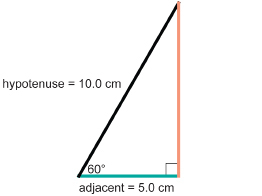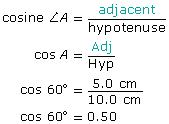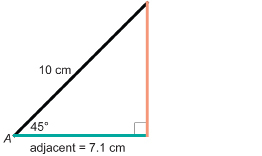Module 7
1. Module 7
1.26. Page 4
Module 7: Trigonometry
Bringing Ideas Together
In Explore you examined the ratio in right triangles of the side adjacent to the hypotenuse. This ratio is another example of a trigonometric function. You saw that, for similar right triangles and a particular acute angle, the ratio ![]() was the same value regardless of the size of the right triangle.
was the same value regardless of the size of the right triangle.

cosine ratio: the ratio of the length of the side adjacent to the length of the hypotenuse
This ratio is called the cosine ratio.
The cosine ratio is always in relation to an acute angle (in this case, ∠A). You must identify the acute angle when you write the cosine ratio in a particular situation.
So, cosine ![]() . It is often written more simply as
. It is often written more simply as ![]() .
.
Example 1
Draw a right triangle with an acute angle of 60°. Determine cosine 60° to two decimal places.
Solution
It does not matter how large you draw the triangle as all right triangles with a 60° angle will be similar in shape. However, a hypotenuse of 10 cm will make the calculation easier.
Once you draw the triangle, measure the adjacent side and hypotenuse to the nearest millimetre.


A ratio of 0.5 means that, in a right triangle with a 60° angle, the adjacent side will be one half the length of the hypotenuse. For instance, if the adjacent side were 30 in, the hypotenuse would be 60 in long, and ![]() .
.
Example 2
Determine cos 45°, correct to two decimal places, by measuring the sides of a right triangle.
Solution
Draw a suitable right triangle. You may wish to draw a right triangle with a hypotenuse of 10 cm to simplify the calculation. Then measure the adjacent side.


Note: This answer is only approximate since measurements were only correct to the nearest millimetre.
This ratio means the adjacent side is shorter than the hypotenuse and is 0.71 times as long. So, if the hypotenuse were 20 cm long, the adjacent side would be about 20 × 0.71 cm = 14.2 cm long.
 Self-Check
Self-Check
Use the method of the previous two examples to complete the following table. You may wish to use 10 cm for the hypotenuse.
SC 6. Complete the following table.
|
Angle |
Hypotenuse |
Side Opposite |
Cosine |
|
10° |
|
|
cos 10° = |
|
20° |
|
|
cos 20° = |
|
30° |
|
|
cos 30° = |
|
40° |
|
|
|
|
45° |
10 cm |
7.1 cm |
cos 45° = 0.71 |
|
50° |
|
|
|
|
60° |
10 cm |
5.0 cm |
cos 60° = 0.50 |
|
70° |
|
|
|
|
80° |
|
|
|
The Cosine Ratio
Look at the table of cosines you prepared. What do you notice about the value of the cosine ratio? When the angle is close to 0°, what happens to the cosine ratio as you move from 0° to 80°? How does this compare to what happens with the sine ratio?
As you have seen just seen and as their names suggest, cosine and sine ratios are related. You will now explore some other relationships that exist between the cosine and sine ratios.
Fill in the sine ratios in the table. What pattern can you see between the cosine and sine ratios?
|
Angle |
Cosine |
Angle |
Sine |
|
10° |
0.98 |
80° |
|
|
20° |
0.94 |
70° |
|
|
30° |
0.87 |
60° |
|
|
40° |
0.77 |
50° |
|
|
50° |
0.64 |
40° |
|
|
60° |
0.50 |
30° |
|
|
70° |
0.34 |
20° |
|
|
80° |
0.17 |
10° |
|
Consider the following right triangle.

So, cos R = sin P.
In Get Started you reviewed complementary angles. In the most recent triangle, ∠R and ∠P are complementary angles.
Therefore, the cosine of an angle is the sine of its complementary angle. In other words, the cosine of an angle and the sine of the angle’s complement match.
The cosine is just the sine of the complement angle. That’s where the name cosine comes from!
Just as for the sine ratio, you can use your calculator to determine the cosine ratio. Be sure your calculator is set to degree mode.
Example 3
Find the value of each of the following. Express each value so that the value is correct to 4 decimal places. Use your calculator.
- cos 45°
- Use your result from a. to find the sine ratio of the complement of 45°.
- cos 60°
- Use your result from c. to find the sine ratio of the complement of 60°.
Solution
- To find cos 45°, press this sequence of keys. If you do not obtain the same numbers in your calculator display, consult your manual. Calculators can vary in the order of key strokes.

You should see something like this.

So, cos 45° 0.7071.
0.7071.
- The complement of 45° is also 45°, since 45° + 45° = 90°.
So, sin 45° = cos 45° 0.7071.
0.7071.
- To find cos 60°, press this sequence of keys. If you do not obtain the answer shown, consult your manual.

You should see something like this.

So, cos 60° = 0.5.
- The complement of 60° is 30°, since 60° + 30° = 90°.
So, sin 30° = cos 60° = 0.5000.
 Self-Check
Self-Check
Use your calculator to complete the following table.
SC 7. Complete this table. Round to four decimal places.
|
Angle |
Cosine |
|
10° |
|
|
20° |
|
|
30° |
|
|
40° |
|
|
45° |
0.7071 |
|
50° |
|
|
60° |
0.5000 |
|
70° |
|
|
80° |
|